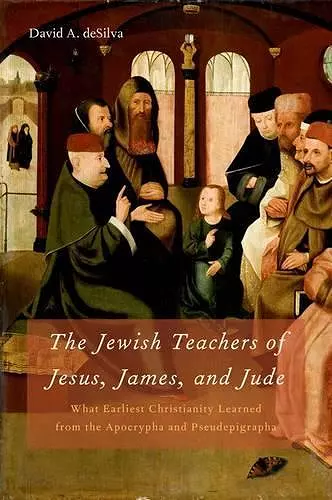The Jewish Teachers of Jesus, James, and Jude
What Earliest Christianity Learned from the Apocrypha and Pseudepigrapha
Format:Hardback
Publisher:Oxford University Press Inc
Published:11th Oct '12
Currently unavailable, and unfortunately no date known when it will be back

Jews have sometimes been reluctant to claim Jesus as one of their own; Christians have often been reluctant to acknowledge the degree to which Jesus' message and mission were at home amidst, and shaped by, the Judaism(s) of the Second Temple Period. In The Jewish Teachers of Jesus, James, and Jude David deSilva introduces readers to the ancient Jewish writings known as the Apocrypha and Pseudepigrapha and examines their formative impact on the teachings and mission of Jesus and his half-brothers, James and Jude. Knowledge of this literature, deSilva argues, helps to bridge the perceived gap between Jesus and Judaism when Judaism is understood only in terms of the Hebrew Bible (or ''Old Testament''), and not as a living, growing body of faith and practice. Where our understanding of early Judaism is limited to the religion reflected in the Hebrew Bible, Jesus will appear more as an outsider speaking ''against'' Judaism and introducing more that is novel. Where our understanding of early Judaism is also informed by the Apocrypha and Pseudepigrapha, Jesus and his half-brothers appear more fully at home within Judaism, and giving us a more precise understanding of what is essential, as well as distinctive, in their proclamation. This comparative study engages several critical issues. How can we recover the voices of Jesus, James, and Jude from the material purporting to preserve their speech? How can we assess a particular text's influence on Jews in early first-century Palestine? How can we be sufficiently sensitive to the meanings and nuances in both the text presumed to influence and the text presumed to be influenced so as not to distort the meaning of either? The result is a portrait of Jesus that is fully at home in Roman Judea and Galilee, and perhaps an explanation for why these extra-biblical Jewish texts continued to be preserved in Christian circles.
What deSilva offers, to put it less catchily than he does, is an admirably close intertextual study of links between, on the one hand, the voice (his term) heard in these letters and in the words of Jesus in the Gospels and, on the other hand, the voice heard in selected works of Jewish literature from the last pre-Christian centuries. This aspect of deSilvas serious and careful study is its major merit and principal claim to originality. * Jack Miles, Common Knowledge *
This volume is vintage deSilva; well written, carefully researched, demonstrating mastery of primary and secondary literature, appropriately cautious yet not affraid to press on with assumptions that may require reconsideration... Readers will come away well informed and inclined toward a greater appreciation of the literary and historical context of Jesus and his brothers. This book is highly recommended for its careful and meticulous attention to points of commonality and differences between the teachings of the NT and selected Jewish texts. * Journal of the Evangelical Theological Society *
ISBN: 9780195329001
Dimensions: 236mm x 155mm x 33mm
Weight: 599g
360 pages